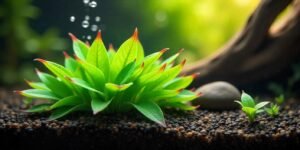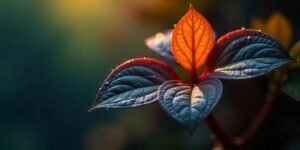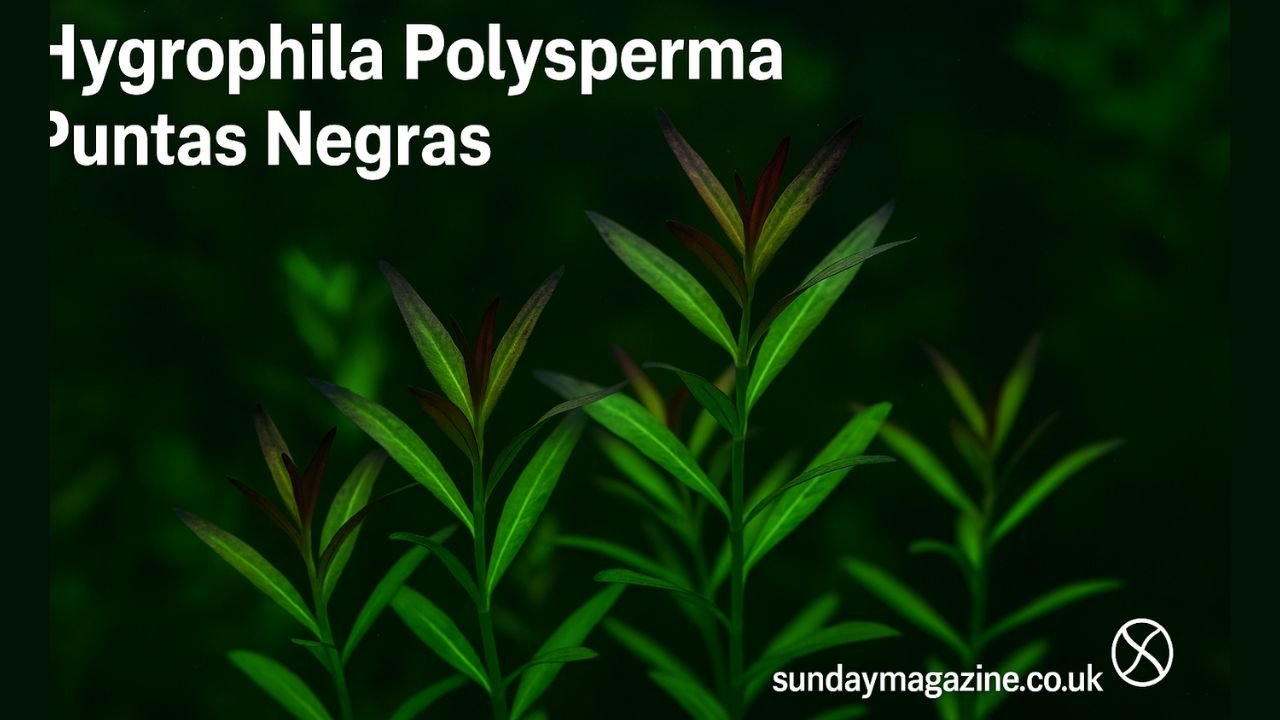Discover expert care tips for Hygrophila polysperma puntas negras, a stunning aquarium plant with dark purple tips. Learn how to keep your Hygrophila polysperma thriving with proper lighting, water parameters, and maintenance for a beautiful tank.
When it comes to aquatic plants that are both beautiful and beneficial for aquariums, Hygrophila polysperma (often referred to as the “dwarf water willow”) is a popular choice among hobbyists. This vibrant and hardy plant species thrives in many different aquatic environments, making it an excellent addition to any tank. In particular, Hygrophila polysperma puntas negras, with its distinctive dark tips, adds a touch of elegance to aquascapes.
If you are considering adding this stunning plant to your aquarium or you already have it but want to improve its health and vibrancy, this article will guide you through essential Hygrophila polysperma care tips, troubleshoot common issues, and provide in-depth answers to frequently asked questions about Hygrophila polysperma aquarium plants. By the end of this guide, you will be well-equipped to create an environment where your Hygrophila polysperma puntas negras can thrive.
ALSO READ: Monstera Albo: The Rare Beauty Your Plant Collection Needs
Introduction to Hygrophila Polysperma Puntas Negras

Before diving into the care aspects, let’s explore what makes Hygrophila polysperma puntas negras so special. Known for its attractive dark-tipped leaves, Hygrophila polysperma is an aquatic plant that grows rapidly in freshwater aquariums. It features elongated stems with soft, green leaves that can vary in color depending on lighting conditions and water parameters. The cultivar “punta negra” refers specifically to the striking black or dark purple tips of the leaves, making it stand out from other variants of Hygrophila polysperma.
This plant is highly valued for its hardiness and adaptability, which allows it to flourish in a wide range of water conditions. With proper Hygrophila polysperma care, your plant can grow rapidly, provide shelter and oxygen for your aquarium inhabitants, and contribute to the overall aesthetic of your tank.
What You Need to Know About Hygrophila Polysperma Care

Hygrophila polysperma care is relatively straightforward, but understanding the plant’s needs and providing the proper conditions is key to keeping it healthy and beautiful. In this section, we will cover the essential factors that influence the growth and health of Hygrophila polysperma puntas negras, including lighting, water parameters, substrate, and fertilization.
Lighting Requirements for Hygrophila Polysperma
Like most aquatic plants, Hygrophila polysperma thrives under moderate to high lighting conditions. The plant requires sufficient light for photosynthesis to produce the energy it needs for growth. Insufficient light will result in slow growth, while too much light can cause algae growth or even damage the plant’s leaves.
Ideal Lighting for Hygrophila Polysperma Puntas Negras:
- Intensity: Moderate to high lighting, around 2-3 watts per gallon.
- Duration: Aim for 8-12 hours of light per day. Too much exposure to light can lead to algae blooms.
- Type of Light: Fluorescent or LED lighting with a full-spectrum light will help your plant maintain its vibrant green leaves with the characteristic dark tips.
Water Parameters for Hygrophila Polysperma
Maintaining the right water parameters is critical for the health of your Hygrophila polysperma. This plant is versatile, but it prefers slightly acidic to neutral water, with good filtration to maintain stability.
Recommended Water Parameters:
- pH: 6.5 to 7.5 (slightly acidic to neutral).
- Temperature: 72-82°F (22-28°C).
- Hardness: Soft to moderately hard water (GH 4-12).
- Nitrate Levels: Moderate nitrate levels help support healthy growth, as Hygrophila polysperma is a fast-growing plant that requires a consistent nutrient supply.
If your tank’s water parameters fluctuate dramatically, it may stress the plant, leading to stunted growth or even leaf loss. Stability is the key to a flourishing Hygrophila polysperma aquarium plant.
Substrate for Hygrophila Polysperma
Hygrophila polysperma puntas negras does not have strict substrate requirements, but a nutrient-rich substrate can enhance its growth. You can plant it in a fine-gravel or sand-based substrate, but if you want to provide the best conditions, consider using a substrate with additional nutrients or a special plant soil.
Substrate Tips:
- A nutrient-rich substrate will support better root development and overall plant health.
- If using inert substrate (like regular gravel or sand), supplement the plant’s nutrition with root tabs or liquid fertilizers.
Fertilization for Hygrophila Polysperma
Since Hygrophila polysperma is a fast-growing plant, it requires a steady supply of nutrients, particularly nitrogen, phosphorus, and potassium (NPK), as well as trace elements like iron. In an aquarium without live plants or organic waste to supply nutrients, you’ll need to add fertilizers to ensure proper growth.
Fertilization Tips:
- Liquid Fertilizers: Use balanced liquid fertilizers to provide micronutrients and macronutrients.
- Root Tabs: Insert root tabs in the substrate near the plant to supply nutrients directly to the roots.
- Co2 Injection: While not absolutely necessary, injecting CO2 can further enhance growth and coloration, especially for cultivars like Hygrophila polysperma puntas negras.
Pruning and Maintenance of Hygrophila Polysperma
Pruning is essential to maintaining the health of your Hygrophila polysperma puntas negras. Regular pruning prevents the plant from becoming too leggy or overgrown, keeping it compact and full of vibrant color. Cut back any long or dying stems to encourage new growth and maintain a bushy appearance.
Common Problems with Hygrophila Polysperma Puntas Negras and How to Solve Them

While Hygrophila polysperma is generally a hardy plant, it can sometimes face challenges. Here are some common issues aquarium owners might encounter with Hygrophila polysperma puntas negras and how to solve them:
1. Yellowing Leaves
Yellowing of the leaves can indicate nutrient deficiencies, poor lighting, or poor water conditions.
Solutions:
- Check and adjust your water parameters to ensure stability.
- Add liquid fertilizers or root tabs to correct nutrient deficiencies.
- Ensure that the plant is receiving adequate lighting (but not too much).
2. Stunted Growth
If your plant isn’t growing as quickly as it should, it may not be getting enough light or nutrients.
Solutions:
- Increase the light intensity (but be careful not to cause algae).
- Add fertilizers and consider supplementing with CO2 if you are using high lighting.
3. Algae Growth
Excess light or poor water circulation can cause algae to form on the leaves of Hygrophila polysperma.
Solutions:
- Reduce the lighting duration to 8 hours per day.
- Ensure good water flow and filtration in your aquarium.
- Clean the plant’s leaves regularly to remove algae buildup.
ALSO READ: A Beginner’s Guide to Essential Stylized Anatomy
Conclusion: Hygrophila Polysperma Puntas Negras Care
Hygrophila polysperma puntas negras is a beautiful and versatile aquatic plant that can thrive in many aquarium setups. By providing proper lighting, water conditions, and nutrition, you can enjoy the unique beauty of this plant in your tank. Whether you are a beginner or an experienced aquarist, following the care tips outlined in this article will ensure that your Hygrophila polysperma flourishes, adding a stunning touch to your aquatic landscape.
FAQs about Hygrophila Polysperma Puntas Negras
1. What is Hygrophila polysperma puntas negras?
Hygrophila polysperma puntas negras is a variety of the Hygrophila polysperma plant, known for its unique dark purple or black tips on the leaves. It’s a popular choice for aquariums due to its vibrant appearance and ease of care.
2. How do I care for Hygrophila polysperma in an aquarium?
To care for Hygrophila polysperma, provide moderate to high lighting, maintain stable water parameters (pH 6.5-7.5, temperature 72-82°F), and ensure nutrient-rich substrate. Regular pruning and adding fertilizers will support healthy growth.
3. Why are the leaves of my Hygrophila polysperma turning yellow?
Yellowing leaves are often a sign of nutrient deficiency, poor lighting, or improper water conditions. Check your water parameters, adjust lighting, and consider adding fertilizers to address the issue.
4. Can Hygrophila polysperma grow without CO2 injection?
Yes, Hygrophila polysperma can grow without CO2 injection, though adding CO2 can promote faster growth and more vibrant coloration, especially for Hygrophila polysperma puntas negras.
5. How fast does Hygrophila polysperma grow?
Hygrophila polysperma is a fast-growing plant. With proper care, it can grow rapidly, often requiring frequent pruning to keep it in check and prevent it from overtaking the aquarium.





